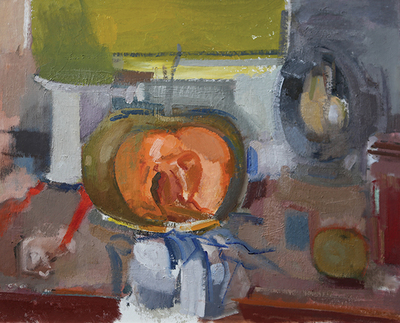RUTH MILLER AND ANDREW FORGE
Ruth Miller, Open Pumpkin and Lantern, 2016, oil on board 24 x 30”. Photo: Ramsay Turnbull
According to Ruth Miller, when Andrew Forge first saw her drawings, he “knew she was for him.” They married, and painted and taught in conversation with each other for 30 years, until Forge’s death in 2002. This show beautifully displays Miller and Forge’s individual oeuvres, as well as the generative connection of these renowned artists and educators.
Forge’s characteristic “dot” paintings—shimmering, abstract canvases filled with small painted marks—hang in the front room of the gallery. Despite concrete titles such as Pond and Torso, no motif is visible. Instead, colors mingle and coalesce, producing a flickering light that is elegiac and specific. In Tent (1992–3) small dark lines dance with dots, as if the “tent” holds a wedding. In Heavy Hemlocks II (2000), dots organize into looming dark vertical forms framed by golden light. The joy remains, but deepens, in Miller’s words, to “gravitas.”
Miller’s still life painting—many recent, which is notable as she is 86 years old—fill the middle room. They portray mundane objects including pumpkins and cabbages, which Miller acknowledges might be interpreted as self-portraits. Brush marks are evident, in the New York Studio School tradition, and reveal how the works are made. In Open Pumpkin and Lantern (2016), Miller depicts a centrally placed pumpkin that has been neatly cut into, suggesting an act of determined probing. The exposed innards blur into graceful brushwork, perhaps symbolizing the central role that painting has played in Miller’s life.
The third, most intimate room in the gallery intermingles the couples’ works on paper in a variety of mediums, including pencil, charcoal, watercolor and gouache. Their drawings burst with intelligence and rigor, and yet seem unfinished, retaining open spaces and unresolved areas. Like Cézanne, Miller and Forge are not interested in description, but rather revelation: of something ineffable that can only be seen through engagement with the observed world. “You want something unknown to look back at you. It is saying it has a right to come forth, a necessity,” says Miller. This rare and precious quality—ungraspable yet powerfully real—animates the entire exhibition.

